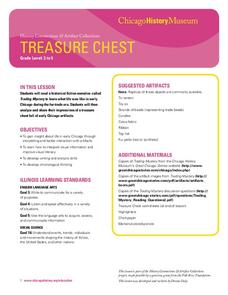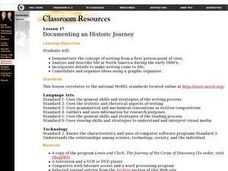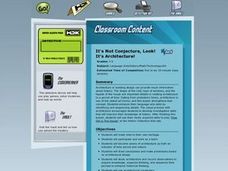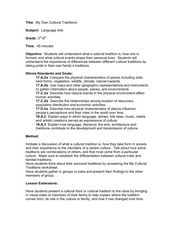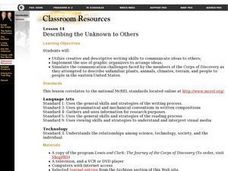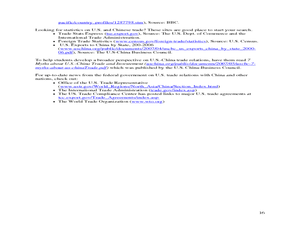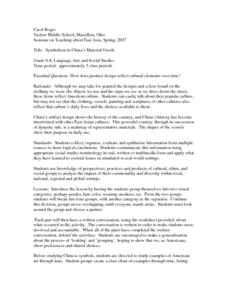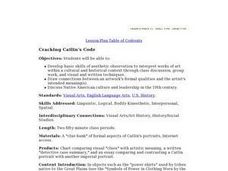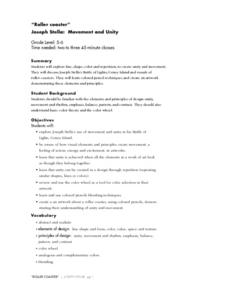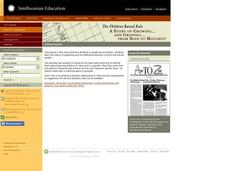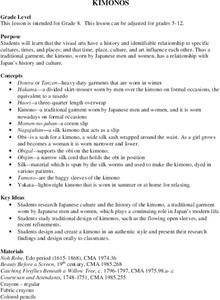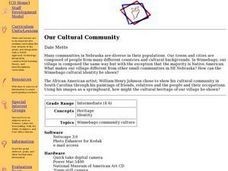Curated OER
Molded Clay Faces
Artists create clay masks using pre-formed molds, clay, glitter, feathers, gems, and paint. The expressive qualities of clay are perfect for creating many different types of face masks, from Mardi Gras glitter to Japanese Kabuki to...
Curated OER
Treasure Chest
Students explore Chicago in the fur-trading era. In this Chicago lesson, students discover what life what like during this time. Students read an historical fiction story about life in the fur-trade era. Students view replicas of...
Curated OER
Navajo Weaving
Students explore the Navajo culture. In this Navajo Indians lesson, students gain information about their weaving and dancing. Students note the patterns in the weaving. Students create a dance that corresponds with the patterns they see...
Public Media for Northern California
An Educator’s Guide to Teaching Gun Control Issues | The Lowdown
The topic of gun control is vast, controversial, and difficult to introduce to students. This gem of a resource covers both sides of the issue and provides topic background, various multimedia and print resources, analysis questions, and...
Curated OER
Documenting an Historic Journey
Students read and analyze journals written by Lewis and Clark. They watch and discuss a video segment, complete a graphic organizer, and write a journal entry written from the point of view of someone involved with the Lewis and Clark...
Curated OER
It's Not Conjecture, Look! It's Architecture!
Students examine how architecture reflects historical time periods. They conduct research on the History Detectives website, complete a fact sheet, sequence photographs of different architectural styles, and create an illustration of a...
Curated OER
Living Legacies
Students explore the contemporary commemoration of Dr. Martin Luther King, Jr., research the positive impact another famous person has had on society and the images that best represent the actions and beliefs of that person.
Curated OER
Secrets of the Parthenon
Students take a closer look at the Parthenon. In this world monument lesson plan, students watch PBS video segments about the reconstruction of the Parthenon in Greece. Students research how the ancient Greeks built the structure and...
Curated OER
My Own Cultural Traditions
Students complete a worksheet on personal traditions. In this cultural traditions lesson, students discuss what a cultural tradition is and why they are important to the members of the culture. Students distinguish between cultural...
Curated OER
Describing the Unknown to Others
Students examine the challenges faced by the Corps of Discovery on the Lewis and Clark expedition. They listen to online journal entries written by members of the Corps, complete an activity sheet, watch a video segment, and write a...
Curated OER
Title of Segment: Balance of Trade
Students take a closer look at the balance of trade. In this current events instructional activity, students watch PBS video clips about American trade with China. Students research Chinese production and consumerism in order...
Curated OER
Sanctuary: Quail Island Banks Peninsula
Students consider the connection between the past and future landscape of Quail Island. In this visual arts lesson, students observe existing artwork, art vocabulary, and connections to the role of social sciences when painting...
Curated OER
Symbolism in China's Material Goods
Students make a generalization about the process of 'looking' and 'grouping', hoping to show that we, as Americans, show preferences and shared choices. They study examples of American art through time and create a class chart...
Curated OER
Making a Mola
Sixth graders explore the term mola. In this social studies lesson, 6th graders create a visual representation of a mola. Additionally, students design their own mola to include important parts of their lifestyle.
Curated OER
Personal Homage
Learners research an African American person of interest to them. Once the research is complete, they share the information with the class. They also create a visual or written portrait of the person to show their character and...
Curated OER
Cracking Catlins's Code
Students create a chart comparing visual clues with artistic meaning. This lesson plan is designed to introduce students to the ways in which consistent patterns of gesture and pose chosen by an artist (specifically George Catlin)...
Curated OER
African-American Artists
Students conduct research on a chosen African-American artist. They research how the artist's community influenced his art, analyze how themes are conveyed through the art, and create a collage depicting the artist's themes.
Curated OER
Pictures Telling Stories
Learners see the importance of primary sources in the study of history, but also the limitations of relying only on primary sources of taking the money, as it were, at face value.
Curated OER
Joseph Stella: Movement and Unity
Students explore line,shape,color and repetition,to create unity and movement. They discuss Joseph Stella's Battle of Lights, Coney Island and visuals of roller coasters. They use colored pencil techniques and create an artwork.
Curated OER
Baga Drum
Students examine a Baga Drum in order to explore the history of the Baga people of West Africa. In this art history lesson plan, students recognize figures used in Baga Drum design that represent aspects of Baga culture. They also design...
Curated OER
Kimonos
Learners create their own kimono design after researching the history, tradition, and techniques of kimono design and production. This art lesson can be connected easily to the Language Arts and/or Social Sciences.
Curated OER
Native American Folklore
Students create a paper that differentiates between written and oral history. They also create a visual narrative that is interpretative.
Curated OER
Our Cultural COmmunity
Students create tiles to create a project that helps students to reflect upon culture. The concept of multicultural education is necessary to help create a community of learners. Brainstorming is the main skill that is used for students...
Curated OER
It's a Wrap!
Learners study two-dimensional and three-dimensional objects by assembling a sculptural piece from something very flat - pieces of newspaper or wallpaper. They see what materials people used to make clothing during the depression.

